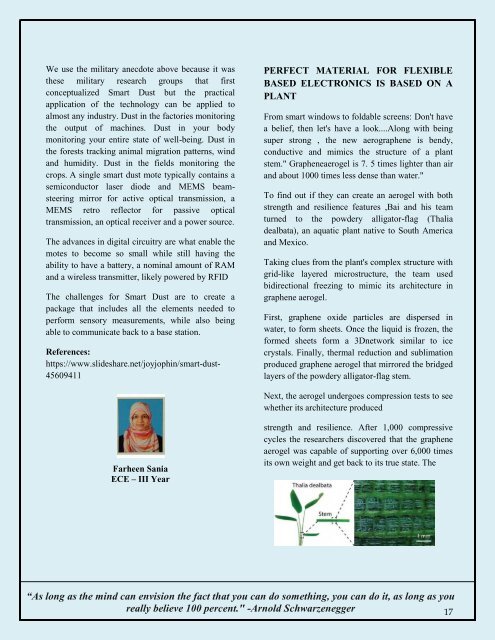B-Smart_July'17
You also want an ePaper? Increase the reach of your titles
YUMPU automatically turns print PDFs into web optimized ePapers that Google loves.
We use the military anecdote above because it was<br />
these military research groups that first<br />
conceptualized <strong>Smart</strong> Dust but the practical<br />
application of the technology can be applied to<br />
almost any industry. Dust in the factories monitoring<br />
the output of machines. Dust in your body<br />
monitoring your entire state of well-being. Dust in<br />
the forests tracking animal migration patterns, wind<br />
and humidity. Dust in the fields monitoring the<br />
crops. A single smart dust mote typically contains a<br />
semiconductor laser diode and MEMS beamsteering<br />
mirror for active optical transmission, a<br />
MEMS retro reflector for passive optical<br />
transmission, an optical receiver and a power source.<br />
The advances in digital circuitry are what enable the<br />
motes to become so small while still having the<br />
ability to have a battery, a nominal amount of RAM<br />
and a wireless transmitter, likely powered by RFID<br />
The challenges for <strong>Smart</strong> Dust are to create a<br />
package that includes all the elements needed to<br />
perform sensory measurements, while also being<br />
able to communicate back to a base station.<br />
References:<br />
https://www.slideshare.net/joyjophin/smart-dust-<br />
45609411<br />
PERFECT MATERIAL FOR FLEXIBLE<br />
BASED ELECTRONICS IS BASED ON A<br />
PLANT<br />
From smart windows to foldable screens: Don't have<br />
a belief, then let's have a look....Along with being<br />
super strong , the new aerographene is bendy,<br />
conductive and mimics the structure of a plant<br />
stem." Grapheneaerogel is 7. 5 times lighter than air<br />
and about 1000 times less dense than water."<br />
To find out if they can create an aerogel with both<br />
strength and resilience features ,Bai and his team<br />
turned to the powdery alligator-flag (Thalia<br />
dealbata), an aquatic plant native to South America<br />
and Mexico.<br />
Taking clues from the plant's complex structure with<br />
grid-like layered microstructure, the team used<br />
bidirectional freezing to mimic its architecture in<br />
graphene aerogel.<br />
First, graphene oxide particles are dispersed in<br />
water, to form sheets. Once the liquid is frozen, the<br />
formed sheets form a 3Dnetwork similar to ice<br />
crystals. Finally, thermal reduction and sublimation<br />
produced graphene aerogel that mirrored the bridged<br />
layers of the powdery alligator-flag stem.<br />
Next, the aerogel undergoes compression tests to see<br />
whether its architecture produced<br />
Farheen Sania<br />
ECE – III Year<br />
strength and resilience. After 1,000 compressive<br />
cycles the researchers discovered that the graphene<br />
aerogel was capable of supporting over 6,000 times<br />
its own weight and get back to its true state. The<br />
“As long as the mind can envision the fact that you can do something, you can do it, as long as you<br />
really believe 100 percent." -Arnold Schwarzenegger<br />
<strong>17</strong>





